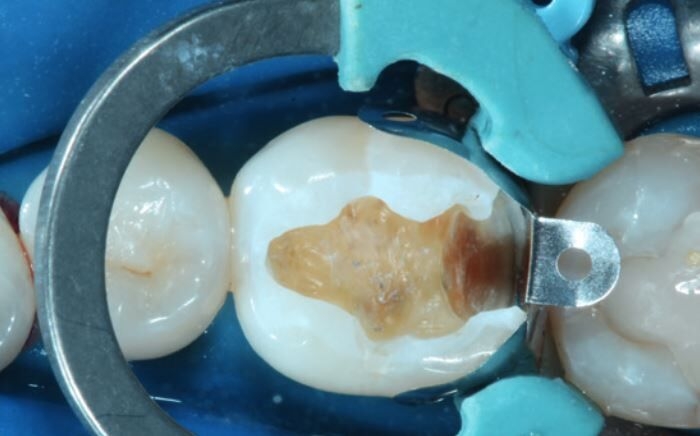Connect with one of our Restorative product specialists to learn how our Class II Restoration products can help you provide better procedures and more comfort for your patients.
What is tooth isolation?
Tooth isolation in dentistry refers to the process of isolating a specific tooth or a group of teeth from the surrounding oral environment during various dental procedures. This isolation is typically achieved using techniques such as rubber dam placement or specialized isolation devices. The primary purpose of tooth isolation is to create a clean, dry, and contamination-free field, ensuring optimal conditions for procedures like restorations, fillings, crown placements, and root canal treatments. By preventing saliva, blood, and moisture from reaching the treatment area, tooth isolation enhances the quality of dental work, minimizes the risk of infection, and improves patient comfort during the procedure.
How do you isolate a tooth?
Isolating a tooth involves several techniques to create a controlled environment for dental procedures. One common method is using a rubber dam, a thin sheet of latex or non-latex material, placed around the tooth. The dentist stretches the rubber dam over a metal frame or a series of small lamps, securing it around the tooth to be treated. This isolates the tooth from the rest of the oral cavity, preventing saliva, blood, and debris from interfering with the procedure. Dental professionals might also use isolation devices that utilize suction to keep the area dry and free of contaminants. Isolating a tooth improves the accuracy and success of dental work, allowing dentists to work with precision and patients to experience a more comfortable procedure.
Guide to Better Tooth Isolation in Dentistry
Ask any dentist what the main causes of procedure failure are and inadequate tooth isolation will undoubtedly be close to the top of the list. Even though it’s been a staple of modern dentistry for decades, isolation remains a pesky but critical step in both endodontic and restorative procedures. It’s not just one aspect of isolation that makes it difficult—tooth isolation by nature isn’t easy, and when you add in trying to keep your patient comfortable and happy it can seem like an impossible task.
Here at Dentsply Sirona, we’re focused on empowering you to provide the best possible dental care to your patients. To help you do this, we’ve summarized the basics you should consider to provide better tooth isolation, ensuring an optimal restorative field is completely isolated, prepped, and ready for the next stage in the restorative procedure.
Why isolate?
The goals of isolation in dentistry are straightforward – avoid contamination of the restorative field and protect the patient against unwanted contact with products used in endodontic or restorative therapy. Today’s restorative procedures are mainly based on adhesive dentistry with isolation being most critical for success. If the restorative field is contaminated with salvia, the physical properties and ultimate success of the restoration may be compromised. Maintaining isolation throughout the entire procedure ensures the best possible outcome for restorative as well as endodontic procedures. The primary aim of endodontic treatment is to reduce the bacterial burden as much as possible. When done correctly, proper tooth isolation helps avoid additional bacterial contamination as well as the unwanted contact of rinsing solutions with healthy soft tissue.
The challenges with isolation in dentistry
Tooth isolation in dentistry is one of the most important aspects of modern restorative procedures, but it doesn’t come without its challenges. The most common form of isolation is using rubber dental dams, which can be uncomfortable for patients and in some clinical situations cannot be used due to access.

Challenging restorative situations
In a common clinical scenario, the prepared tooth is effectively isolated and the patient is tolerant of the total procedure time, meaning they are able to keep their mouth open, breathe through their nose and control their tongue. Challenging clinical scenarios are situations where effective tooth isolation might not be guaranteed for the total procedure time.
Today, 97% of clinicians say that achieving proper isolation of a Class II cavity is difficult in at least 1 out of 10 cases,1 justifying the need for a better alternative to the materials currently available for challenging cases.
Clinicians often turn to Glass Ionomer (GI)/Resin Modified Glass Ionomer (RMGI) materials when isolation is difficult or compromised knowing that the procedure time needed for such self-adhesive materials is much shorter and they allow for proper isolation during the critical steps. This option, however, comes with a compromise as current GI/RMGI materials will not support occlusal loading and will likely require frequent replacement as current studies indicate an annual failure rate of 25.8%.2
The solution? Turn to a trusted partner – Dentsply Sirona
Our goal is to empower you to provide the best possible care to your patients, which is why we’ve created our procedure solution for Class II Restorations. We’ll help you bring increased predictability to your procedures and more efficiency to your practice, providing you with the tools and training you need to implement solutions for a better practice all around.
Contact us for more information
Please contact us for more information about Restorative.
- Dental Learning Systems, Direct Restoratives Survey, May 2016. N=143
- Hickel et al: Longevity of occlusally-stressed restorations in posterior primary teeth. Am J Dent. 2005
- Internal data on file. For more information, contact Consumables-Data-Requests@dentsplysirona.com